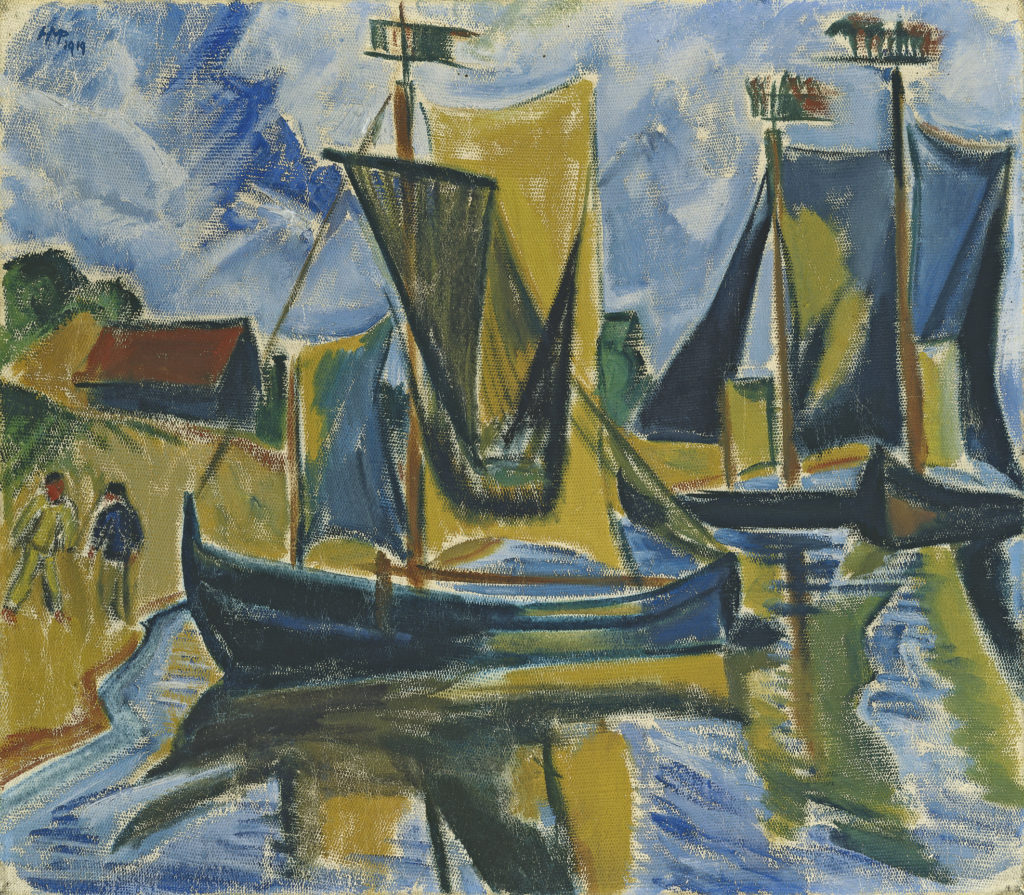Keitelkähne

Together with Ernst Ludwig Kirchner, Karl Schmidt-Rottluff and Erich Heckel, Max Pechstein (1881-1955) participated in founding the German expressionist group Die Brücke in 1905. The artists worked chiefly with painting and graphic art, but also with sculpture and functional objects. In general one could say that their style was rough and angular, and characterised by a vibrant and forceful palette. The works are marked by a raw primitivism, which is particularly evident in their black and white woodcuts, and in their interest in the art of indigenous peoples. This primitivism is associated with a common European search for something “original” and “genuine” during that period; compare for example Gauguin in Bretagne, van Gogh in Arles and our own Nikolai Astrup in Jølster. The group was formally disbanded in 1913, but the artists continued to work in an expressionistic style, which is visible for example in Pechstein’s Keitelkähne from 1919.
During the group’s formative years, the artists were especially interested in Edvard Munch’s artwork, and they considered him as being both a spiritual and artistic model. They came in contact with his work through Gustav Schiefler, a German solicitor who composed the first catalogue of Munch’s graphic works. Among other things, the Brücke artists wanted Munch to join the group, and they attempted several times to invite him to participate in exhibitions, but to no avail. Aside from their enthusiasm for Munch, Die Brücke had a very concrete relationship to Norway, as they exhibited their work at Blomqvist in 1908 – one of their very first exhibitions outside of Germany. In the summer of 1911, Schmidt-Rottluff visited the village of Lofthus in Hardanger, where he made several paintings that are considered among the masterpieces of his oeuvre. An addition, the Brücke artists participated in an extensive and art historically very important show of young German artists at Kunstnernes Hus in Oslo in 1932. This was coincidentally the last large official presentation of modern German art abroad before Hitler’s takeover of power. The exhibition had great significance for the development of a handful of young, Norwegian artists, who were later given the sobriquet “the modernists of the 30s”: among others Sigurd Winge, Bjarne Engebret and Gert Jynge. After having seen the exhibition, they began to work in an idiom that closely resembles the German expressionists. Pechstein’s Keitelkähne has many of the qualities that are characteristic of Die Brücke, with the rough, hewn style and the dry and forceful palette. Another interesting point is that it was pictures of this type that captured Gert Jynge’s attention especially at the exhibition in ’32, and Jynge’s own works from the early 30s are very much related to pictures of this very kind.
There are very few works of the German expressionists in public Norwegian collections. The underlying reason for this is that the Norwegian art scene from the end of the 1800s and for nearly one hundred years since, was for the most part oriented towards Paris and French art. It wasn’t until the 1970s that this focus shifted to a degree, as certain young Norwegian art historians began to show an interest in the material. The absence of German expressionism was in time perceived as a lacking element in the museum collections. Especially when seen in relationship to Edvard Munch’s position. He is, as we know, abundantly represented in the National Museum’s collection with a number of masterpieces, yet he does not naturally belong in the French context that he of necessity must be placed in there. Munch was oriented towards Germany and German art and he was, as already mentioned, an important pioneering figure and source of inspiration for the German expressionists. Against this backdrop, the Savings Bank Foundation DNB is in the process of building up a collection of German expressionism, with the intention of a permanent loan to the National Museum.
OWG